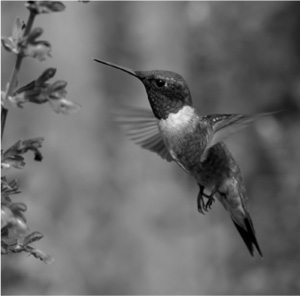Animal BehaviorBehavior of Animals in Motion |
How fast does a hummingbird’s wings move? |
Hummingbirds are the only family of birds that can truly hover in still air for any length of time (although such birds as Kestrels do hover, it is not for as long). They need to do so in order to hang in front of a flower while they perform the delicate task of inserting their slim sharp bills into the flower’s depths to drink nectar. Their thin wings are not contoured into the shape of aero-foils, so they do not generate lift in this way. Instead, their pad dle-shaped wings are, in effect, hands that swivel at the shoulder. They beat them in such a way that the tip of each wing follows the line of a figure-eight lying on its side. The wing moves forward and downward into the front loop of the eight, creating lift. As it begins to come up and goes back, the wing twists through 180° so that once again it creates a downward thrust. The hummingbird’s method of flying does have a major limitation: The smaller a wing, the faster it has to beat in order to produce sufficient downward thrust. An average-sized hummingbird beats its wings twenty-five times a second. The bee hummingbird, native to Cuba, is only 2 inches (5 centimeters) long—it beats its wings at an astonishing 200 times a second.

The remarkable hummingbird can hover in place as it flaps its wings dozens of times per second. The ruby-throated hummingbird (pictured here) flaps its wings 50 times per second, while the bee hummingbird can beat its wings an astonishing 200 times per second.
